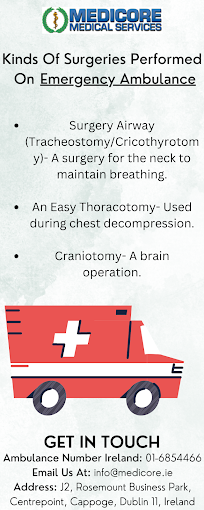The Financial Aspects of Emergency Ambulance Services: Funding, Insurance, and Costs
Emergency ambulance services play a crucial role in our healthcare system, providing life-saving assistance during medical emergencies. While the primary focus of these services is on patient care, it is essential to understand the financial aspects that support their operations.
In this blog post, we will delve into the funding sources, insurance considerations, and costs associated with ambulance services.
Funding Sources for Emergency Ambulance Services: Emergency ambulance services are typically funded through a combination of public and private sources. Here are some common funding mechanisms:
Government Funding: Many ambulances receive financial support from federal, state, or local governments. These funds may come from taxes, grants, or specific healthcare allocations. Government funding ensures that emergency services are accessible to all individuals, regardless of their ability to pay.
User Fees: Ambulance services often charge fees for their services, known as user fees. These fees help cover the operational costs of the service. User fees can vary depending on factors such as the distance traveled, the level of care provided, and the specific medical interventions required. Insurance coverage and individual financial circumstances can also influence the final amount billed to the patient.
Subsidies and Donations: Some emergency ambulance services receive subsidies or donations from community organizations, foundations, or individuals. These financial contributions can help bridge gaps in funding and provide additional resources to enhance the quality of care.
Health Insurance: Health insurance policies often include coverage for emergency ambulance services. However, the extent of coverage can vary widely depending on the insurance plan and the terms and conditions set by the insurance provider. Patients should review their insurance policies to understand the coverage limits, copayments, and any restrictions related to ambulance services.
Medical Necessity: Insurance providers typically require that ambulance transportation is medically necessary to provide coverage. The determination of medical necessity is based on the patient's condition and the specific circumstances surrounding the emergency. Insurance companies may require documentation from medical professionals to support the claim for reimbursement.
Out-of-Network Providers: Ambulance services may be categorized as in-network or out-of-network providers by insurance companies. In-network providers have negotiated agreements with insurance companies, resulting in lower out-of-pocket costs for patients. Out-of-network providers, on the other hand, may lead to higher patient expenses, as insurance reimbursement rates may be lower or not applicable.
Base Fees: Ambulance services typically charge a base fee for responding to an emergency call. This fee covers the initial dispatch and arrival of the ambulance at the scene.
Mileage Charges: They may charge additional fees based on the distance traveled to transport the patient to the appropriate healthcare facility. Charges may be calculated per mile or based on predetermined zones.
Advanced Life Support (ALS) vs. Basic Life Support (BLS): The level of care provided during ambulance transportation can affect the cost. Advanced Life Support (ALS) ambulances, equipped with advanced medical equipment and staffed by paramedics, generally have higher fees than Basic Life Support (BLS) ambulances, which provide essential medical care.
Additional Services: Some ambulances may offer additional services such as air transportation or specialized equipment. These services often come with extra charges, reflecting the increased complexity and resources required. Conclusion:
Emergency ambulance services are essential for providing timely and life-saving care during medical emergencies. Understanding the financial aspects associated with these services is crucial for patients, insurance providers, and policymakers. By comprehending the funding sources, insurance considerations, and costs involved, we can work towards ensuring the availability and sustainability of emergency ambulance to meet the needs of our communities.
Insurance Considerations: Insurance coverage plays a significant role in determining the financial responsibility of patients and the reimbursement received by ambulance services. Here are a few key insurance considerations:
Costs Associated with Emergency Ambulance: The costs associated with emergency ambulance services can vary significantly depending on multiple factors. Here are a few cost considerations:






Comments
Post a Comment